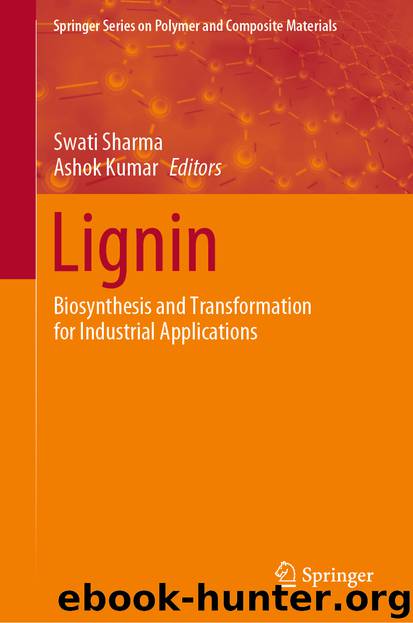Lignin by Unknown

Author:Unknown
Language: eng
Format: epub
ISBN: 9783030406639
Publisher: Springer International Publishing
2.3.4 Polyurethanes
The addition polymerization of di- or polyisocyanates with polyols results in the synthesis of polyurethanes (PU), the reaction of both monomers produce carbamate (urethane) linkages. The PU coatings, spandex fibers, elastomeric wheel, and tires, basic polyurethanes foam products, adhesives, and carpet underlay are some examples of the most known applications of this type of polymer. The applications depend on the monomers used, and the type of reaction applied, which will provide different physical and chemical properties to the final product. Some examples of diisocyanates used are toluene 2,4-diisocyanate, 4,4′-methylene diphenyl diisocyanate (Sáenz-Pérez et al. 2016; Gang et al. 2017), hexamethylene diisocyanate (Karak 2016), and others. Diisocyanates are highly reactive, which is the main advantage of this reaction. However, it is a toxic compound that reacts readily with human cells causing health problems (Hu et al. 2014; Upton and Kasko 2016). By 2021, it is projected to have a market demand of about 6.3 million metric tons of polyurethane for use only in wood and furniture, and the overall global demand is expected to increase even higher than 19 million metric tons (Statista 2019). A report showed that in 2017, the total income generated by the polyurethane industry was USD 37.9 billion (Kevin et al. 2018).
As it was discussed in the previous sections, lignin contains different functional groups and reactive sites in its structure that can be used for the synthesis of polyurethanes. A vast amount of studies have reported the use of renewable materials as a building block to replace petroleum chemicals, and lignin has been proved as a potential material for the polyurethane industry. Recently, biodegradable RPUF was synthesized, lignin with polyol obtained from soy oil, and a polymeric methyl diphenyl diisocyanate were processed through one-pot and self-rising method, resulting in a 3D macromolecular structure with thermal and mechanical properties improved; the biodegradable rigid foams obtained are shown in Fig. 8. The concentrations of lignin powders used on each foam from a to f were 0, 5, 10, 15, 20, and 25% respectively; the foam color shows a variation from light to dark brown color with the increase of lignin percentage (Luo et al. 2018b).
Fig. 8Biobased polyurethane foams obtained using lignin and soy oil-derived polyols at different concentrations of lignin.
Reproduced from Ref. Luo et al. (2018b) with permission from Elsevier
Download
This site does not store any files on its server. We only index and link to content provided by other sites. Please contact the content providers to delete copyright contents if any and email us, we'll remove relevant links or contents immediately.
On Writing A Memoir of the Craft by Stephen King(4892)
The Doodle Revolution by Sunni Brown(4713)
A Simplified Life by Emily Ley(4129)
Mummy Knew by Lisa James(3655)
Marijuana Grower's Handbook by Ed Rosenthal(3641)
Better Homes and Gardens New Cookbook by Better Homes & Gardens(3547)
Figure Drawing for Artists by Steve Huston(3409)
Paper Parties by Erin Hung(3398)
Draw Your Day by Samantha Dion Baker(3318)
The Genius of Japanese Carpentry by Azby Brown(3254)
Japanese Design by Patricia J. Graham(3138)
The Code Book by Simon Singh(3136)
Dangerous Girls by Haas Abigail(2994)
Lions and Lace by Meagan Mckinney(2941)
The Curated Closet by Anuschka Rees(2940)
How to Make Your Own Soap by Sally Hornsey(2866)
The Checklist Manifesto by Atul Gawande(2809)
The Wardrobe Wakeup by Lois Joy Johnson(2754)
Zero to Make by David Lang(2753)
